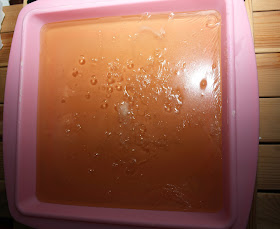Toto je môj prvý pokus výroby mydlovej hmoty- úspech- neúspech.
Úspechom je, že mydlo sa dá roztopiť, dajú sa pridať farbivá, esencie a iné prísady, naliať do formičky a wualaaa mydlo je hotové. Je dokonca trochu priesvitné. Okrem roztoku hydroxidu, olejov, kyseliny steárovej a glycerínu neobsahuje žiadne ďalšie prísady, čo je myslím na hmotu celkom slušné.
Neúspech- vysoká teplota roztápania- to si myslím kvôli tomu ako dlho to trvá, a následné rýchle tuhnutie, takže tvoriť vzory nie je možné. Vysoká teplota tiež spôsobuje, že sa mydlo následne "potí".
Neodradila som vás a chcete si to vyskúšať? Ak už máte za sebou výrobu mydla za horúca (inak neodporúčam na prvkýrat robiť tento recept),tak sa obrňte veeeeľkou dávkou trpezlivosti a pripravte si tieto suroviny:
ricínový olej 90g 30%
bravčová masť 90g 30%
kokosový olej 75g 25%
olivový olej pomace 33g 11%
kyselina steárová 12g 4%
glycerín 300g
voda 95,3g
hydroxid sodný 42,8g
!Bezpečnosť:
Ochranné okuliare, rukavice, dlhé rukávy, vetraná miestnosť. V prípade poleptania pokožky roztokom hydroxidu alebo surovým mydlom, oplachujte postihnuté miesto aspoň 15 min pod tečúcou vodou.
Postup:
Postup:
- Odvážime si všetky suroviny
- Postupne nasypeme hydroxid do vody- NIKDY NIE NAOPAK a miešame kým sa rozpustí, necháme vychladnúť na približne 38℃
- Tuk a kyselinu stearovú si rozpustíme a pridáme oleje- takto nemusíme dlho čakať kým vychladnú, tentokrát som pracovala s teplotou okolo 40℃ (musela som to nechať vychladnúť, pretože kyselina stearová potrebovala dosť vysokú teplotu na roztopenie)
- Hrniec s olejmi vložíme do vodného kúpeľa- čiže do druhého hrnca naplneného s vodou, tak aby bol hrniec s mydlom vo vode ponorený
- Roztok hydroxidu pomaly vlejeme do olejov, premiešame- hmota hustla veľmi rýchlo, ponorný mixér nebolo treba, len miešať o život
- A tu už začína tá trpezlivá a nedočkavá časť- mydlo najskôr vyzerá ako "klasické" vyrobené metódou zahorúca, čiže niečo ako vazelínová zemiaková kaša
- Pridajte glycerín a miešajte, z mydla sa postupne stáva tekuté - táto fáza trvala takmer tri hodiny, mala som pocit, že sa to nikdy celé nerozpustí, nakoniec na povrchu zostala akoby pena- škrupina, ktorú som dookola vmiešavala a snažila sa rozpustiť a ona sa znovu stihla vytvoriť
- Ak je mydlo tekuté, len na povrchu sa tvorí pena- škrupina, odstráňte ju, mydlo nalejte do formy, nechajte vychladnúť a stuhnúť, na druhý deň vyklopte
tu vidieť na slnku, že je trochu priehľadné
a tu som už odlievala s pridaním glycerínovej farby
Na záver ešte pridám recept, z ktorého som vychádzala, ale kedže som nechcela použiť palmový olej, tak som si oleje trochu zamenila. Link je TU.
Budem rada za všetky vaše nápady a pripomienky, ako vylepšiť tento receptík 😊
























